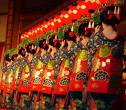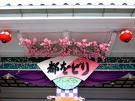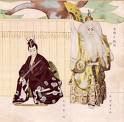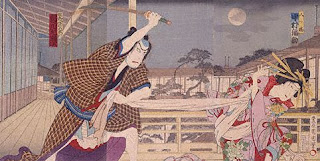:::::::::::::::::::::::::::::::::::::::::::::::::::::::::::::::::::::::::::::::::::::::::::::::::::
Kyoto Festivals in April
***** Location: Kyoto
***** Season: April
***** Category: Observance
*****************************
Explanation
Annual Festival at Matsuo Shrine
松尾大社(まつおたいしゃ) (Reisai Matsuo Taisha, Matsu no O Shrine)
April 2
The deity of the shrine is known as a God of Japanese sake.
Visitors can enjoy a Kyogen performance by the Shigeyama Family and a Noh performance by the Kongo School.
Matsunoo omatsuri oide 松尾祭御出 まつのおまつりおいで
Come to the Matsunoo Festival
- - - - - - - - - -

Kangetsu Matsuri, kangetsumatsuri 観月祭
Moon Viewing Festival
On the Full Moon night in September or October
With a great performance of drums and other classical music and
an autumn moon viewing haiku meeting
観月 俳句大会.
The three gardens are lit up also.
. Matsuo Basho 松尾芭蕉 Haiku Poet
. Kangetsu 観月 Moon Viewing in Autumn
Details of the shrine
Matsunoo Taisha 松尾大社 Matsunoo Grand Shrine
Matsuno'o Taisha
Matsunoo Jinja 松尾神社 Matsunoo Shrine
:::::::::::::::::::::::::::::::::::::::::::::::::::::::::::::::::::::::::::::::::::::::::::::::::::
Other festivals in Kyoto in April
Go-o Taisai Festival
Apr 04
Go-o-jinja Shrine
Saga Dai Nenbutsu Kyogen
Apr 06
Seiryo-ji Temple
Shakuson Kotan Festival
Apr 08
Outdoor tea ceremony
Ryozan Kannon
. Hana Kuyo Festival - Apr 10 - Kurama-dera Temple
Cherry Blossom Festival
Apr 10
Hirano-jinja Shrine
Ketsugan ceremony April 24
Hoyoke-taisai
(Grand Festival for warding off misfortune associated with directions)
Apr 11
Ikebana flower arrangement display
Jonangu Shrine
Yasurai Festival
Apr 13
Straw hats are decorated with cherry blossoms and camellia flowers. Red small goblins play music and dance.
Imamiya-jinja Shrine, Genbu-jinja Shrine, Daijingu-sha Shrine
Taiko Hanami Gyoretsu Procession
Apr 13
in honor of Toyotomi Hideyoshi
Daigo-ji Temple
Kamo Kyokusui no En
Apr 13
Kamigamo-jinja Shrine
Jusan Mairi
Apr 13
People celebrate their children’s 13th birthday and pray that their adult lives will be healthy.
Kokuzo Horin-ji Temple
Flower Arrangement Festival
Apr 13
To commemorate the spirit of Emperor Saga.
Daikaku-ji Temple
Spring Reisai Festival
Apr 14
For the God of kemari kickball.
Shiramine-jinja Shrine
Chuyu Festival
Apr 15
Shrine Matsuo-taisha.
Spring Reisai Festival
Apr 17
to commemorate the anniversary of the death of Empress Jingu
Shrine Gokonomiya-jinja
Yoshida Festival
Apr 18
Yamato-mai special dance performance.
Yoshida-jinja Shrine
Gyokitai-e
Apr 18
To commemorate the spirit of the Buddhist saint, Honen.
Kaihaku Memorial Ceremony , Yoshimizu-ko , Hojo-kai
Chion-in Temple
Ominugui Ceremony
Apr 19
For honor the Shaka Nyorai, the Buddha.
Seiryo-ji Temple
Yoshino Tayu Memorial Hana Kuyo
Apr 20
Memoryal for the Buddhist monk Nikkan.
Josho-ji Temple
Shinko Festival
Apr 20
With 6 portabel mikoshi, across the Katsura river.
Matsuo-taisha Shrine
Inari Festival &Shinko Festival
Apr 20
Mikoshi procession to the Otabisho resting place.
Fushimi Inari-taisha Shrine
Mibu Kyogen
Apr 21
For Buddhist Saint Enkaku.
Mibu-dera Temple
Sho Mieige-ku
Apr 21
Memorial for Buddhist monk, Kukai Kobo Daishi.
To-ji Temple
Honen Shonin Memorial Service
Apr 23
Memorial for Saint Honen.
Chion-ji Temple
Kisshoin Rokusai Nenbutsu
Apr 25
Kisshoin Tenmangu Shrine
Kyokusui no Utage
Apr 29
Jonan-gu Shrine
Rokusai Dance
Apr 29
Buddhist monk Kuya started the Rokusai Nenbutsu Dance.
Fushimi Inari-taisha Shrine
.................................................................................
Kyoto festivals for each month are listed here
source : www.kyotoguide.com
*****************************
Worldwide use
Annual Festival at Matsuo Shrine
Dies ist das bedeutendste Festival des Schreins Matsuo Taisha.
Für den Gott der Braukunst werden Kyogen und Noh aufgeführt.
*****************************
Things found on the way
. Matsuo Jinja 松尾神社 in Ishikawa .
this shrine is not related to the poet Matsuo Basho 松尾芭蕉.
It is in the compound of Shrine Tada Jinja 多太神社.
Tofukuji Temple (toofukuji 東福寺)
and master gardener Shigemori Mirei 重森三玲
:::::::::::::::::::::::::::::::::::::::::::::::::::::::::::::::::::::::::::::::::::::::::::::::::::::::::::::::::::::::::::
. hana no miyako 花の都 "capital of blossoms" .
- kigo from Kyoto -
[ . BACK to DARUMA MUSEUM TOP . ]
[ . BACK to WORLDKIGO . TOP . ]
:::::::::::::::::::::::::::::::::::::::::::::::::::::::::::::::::::::::::::::::::::::::::::::::::::::::::::::::::::::::::::























































